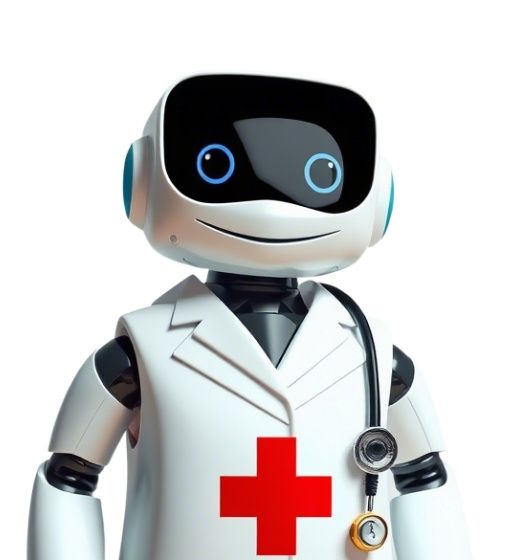Intelligent medical diagnostics
About the project
Our goal: to eliminate inequality in healthcare by 2032. No patient should die because they were born in the wrong place, and the local paramedic turned out to be incompetent.
Our mission is to make robot doctors partners of living doctors, not their replacement. We believe that technology should work for the benefit of society: save lives, improve safety, conserve resources and give people a chance to live much longer and better.
World expertise and the best domestic developments should be available in every office, operating room and not depend on the location, level of education of a particular specialist and his salary. For this, we are developing our robot based on artificial intelligence.
Technical solution
Speech-to-Text
- possible diagnoses (ranked by probability)
- recommendations for additional tests
- links to clinical protocols and articles
Implementation forms:
- Application for the doctor's smartphone/tablet
- A "smart speaker" for appointments in rural clinics, synchronized with an electronic medical record
Robot Doctor
- In real time, the robot assistant analyzes the patient's parameters (pulse, pressure, oxygen level) → warns of risks (for example: "Decreased saturation! Check drainage")
- Projects a 3D model of the organ onto the screen, marking areas for intervention (for example, a tumor on an MRI image)
A trained robot doctor will be able to independently:
- conduct automated surgical operations and subsequent patient rounds
- conduct dental operations, check vision, study images
- receive patients even where a human doctor is absent
Global Medicine
- Each case (with the patient's consent) is anonymously sent to the cloud → AI learns from current data
- Doctors from different cities and countries supplement the algorithms
- Works even at low internet speeds
- Compatibility with inexpensive medical gadgets is supported
- Weekly algorithm updates
- The algorithm takes into account dialects and simplified vocabulary (important for elderly patients)
Stage 1: Development of an application with AI for medical consultations.
The program analyzes symptoms, medical history, checks against an extensive medical database and offers the doctor a probable diagnosis. This will enhance the work of medical specialists of any level, ensure the safety of medical records and open the way to the development of personalized medicine.
Key features:
- AI does not replace the doctor, but enhances him, as an assistant with access to all the medical knowledge of mankind
- The more doctors use the platform, the more accurate his diagnoses become
- RoboDoc will not lose a medical record with a medical history, it is an ideal tool for timely prevention
Key systems: AI assistant, medical knowledge base
- DxGPT.app by Microsoft is an international neural network service for diagnosing diseases
- MosMedII.rf is a diagnostic and telemedicine center in Moscow. Tools that take into account the best practices of the capital and local characteristics of our country
Stage 2: Development of a medical robot assistant
- Integration of a robot doctor and a robotic surgery module
- Conducting an appendectomy, when a surgeon from Moscow remotely controls the robot
- Pre-training of the robot, through repetition and improvement of the actions of a human doctor during operations
- Independent operation by the robot
Key stages of development:
- Creation of a medical robot, in collaboration with Robee Robotics
- Adaptation and training of the robot
- Adaptation of medical personnel
- Result: the disease is detected at an early stage, the patient is saved without a trip to the city
- Result: postoperative complications prevented, recovery time reduced by 30%
- Result: patient received treatment in 2 hours instead of 2 days waiting for ambulance
Mobile application
- Improving the quality of patient careWith accurate diagnoses and streamlined workflows, doctors can offer more effective treatments
- Improving diagnostic accuracyAI analyzes millions of cases and offers the doctor a probable diagnosis. As the number of doctors on the platform increases, the accuracy of diagnoses increases thanks to the accumulated data
- Saving timeThe platform helps to analyze data faster and make informed decisions
- TechnologicalMinimum manual labor, maximum benefit
- Access to the world's medical databaseThe platform uses millions of cases to analyze and compare symptoms, providing a high level of diagnostics
- HumanityHelping people always and everywhere: regardless of their place of residence
- Reducing errorsUsing AI reduces the likelihood of errors in diagnosis and treatment
- Savings on medicinesAccurate diagnoses = accurate prescriptions and correct treatment. No more buying up half the pharmacy for something to help
- Personalized medicineThe robot will never forget the patient’s past problems and will help create an individual treatment plan, adjusting it on the fly, for example, using data from wearable sensors
- Safe storage of medical dataThe platform ensures the safety and availability of medical records, preventing the loss of important information
Objective: development and testing
- Develop an application for a doctor on a smartphone/tablet/PC
- Integrate the functionality of converting voice into text with the recommendation of an AI assistant
- Release of a minimum version of the product with basic functionality
- Pilot in 3 clinics
- Collecting and recording feedback
- Expanding functionality:
— image recognition
— recognition of rare diseases
Goal: to become a valuable tool for doctors
- Integration with medical devices (ECG, ultrasound, etc.)
- Connection and testing on data from 100+ clinics
- Launch of a self-learning medical network, when AI can predict epidemics and helps optimize drug logistics
- Reduction in mortality from preventable causes by 25%
Objective: adaptation of the robot assistant
- Integration of the robot doctor and the robotic surgery module
- Conducting an appendectomy, when a surgeon from Moscow remotely controls the robot
- Pre-training of the robot, through repetition and improvement of the actions of a human doctor during operations
- Independent operation by the robot
- Scaling: expanding coverage to 1 million doctors and patients
The core of our team is made up of engineers and analysts from the country's leading universities and technology corporations:








We believe that a revolution in healthcare is possible only through collaboration.
Our partners are technology innovators and experts who share our mission: to make high-quality medicine accessible to everyone, even in the most remote corners of the planet.

- Common values:All partners share our goal of eliminating inequalities in health care
- Innovation for lifeWe transform the «impossible» into working solutions
- TransparencyAll research is conducted as openly as possible















